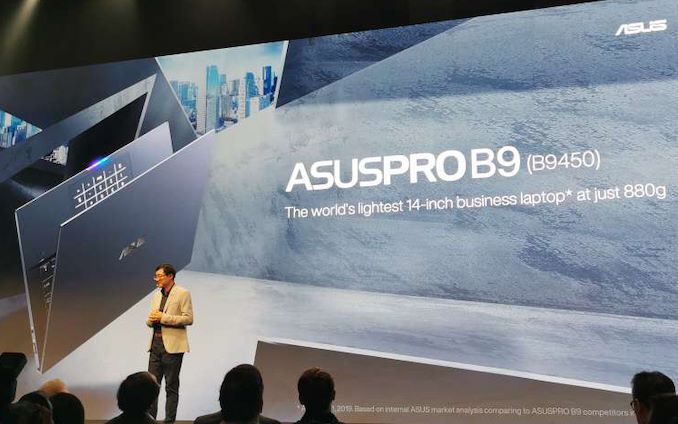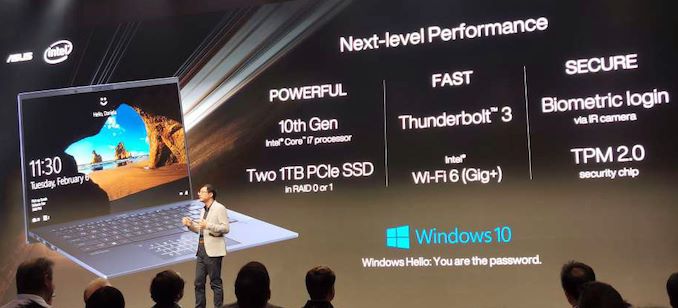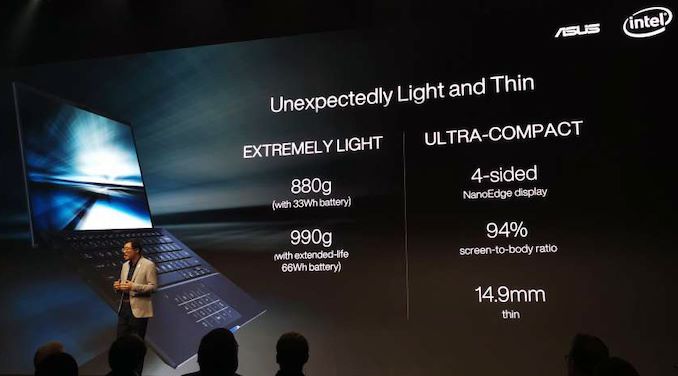ASUS Unveils ASUSPRO B9 (B9450): A 14-Inch Ice Lake Laptop at 880 Grams
by Anton Shilov on September 4, 2019 1:00 PM EST- Posted in
- Notebooks
- Intel
- Asus
- Laptops
- Ice Lake
- Project Athena
- 10th Gen Core
- ASUSPRO

ASUS announced its all-new ASUSPRO notebook aimed at business users who need rich functionality, advanced security, and ultimate portability. Taking advantage of Intel’s Project Athena as well as Intel’s latest Ice Lake platform, the ASUSPRO B9 (B9450) offers rather ultimate capabilities in a package that weighs starting from 880 grams.
Traditionally for ASUS’ thin-and-light business-oriented machines, the ASUSPRO B9450-series laptops come in a 13-inch-class magnesium alloy chassis that is 14.9 mm thick and houses a 14-inch NanoEdge Full-HD display with anti-glare coating and ultra-thin bezels. Due to a reworked internal architecture (courtesy of Intel’s Ice Lake platform), the notebook weighs 880 grams when equipped with a 33 Wh battery or 990 grams when a 66 Wh battery is installed. Besides, the new ASUSPRO B9 can withstand MIL-STD 810G tests (probably ASUS refers primarily to drop tests), so it is pretty rugged too.
Inside the ASUSPRO B9450-series machines is Intel’s 10th Generation Core processors codenamed Ice Lake with up to four cores and advanced Gen 11 graphics. The CPU is accompanied by LPDDR4X memory as well as up to two 1 TB PCIe 3.0 x4 SSDs operating in RAID 0 mode for superior performance or RAID 1 mode for added reliability.
In line with Intel’s Project Athena recommendations, the ASUS PRO B9450 is equipped with Thunderbolt 3 as well as Wi-Fi 6 connectivity. Furthermore, it has a Windows Hello-capable webcam with IR sensors as well as a TPM 2.0 chip for ultimate security.
ASUS plans to start sales of the ASUSPRO B9450-series notebooks in the near future. Exact configurations and prices will be disclosed when the laptops are available.
Related Reading:
- ASUS PRO B9440: Durable Ultra-Thin Business Laptop with 10-Hour Battery for $999
- ASUS ZenBook Pro Duo UX58: A Dual Screen Laptop with 100% DCI-P3 OLED
- ASUS Unveils ZenBook Edition 30 Laptop: 13.3-Inch Dual Screen with GPU
- CES 2019: ASUS Reveals StudioBook S W700 Workstation with Xeon & Quadro
Source: ASUS












16 Comments
View All Comments
Great_Scott - Wednesday, September 4, 2019 - link
I guess I'm not seeing the point of this. Most business laptops are already somewhere between 1 and 3 kilos and are plenty portable. Reducing the diagonal size somewhat is nice. but again not really needed.Dug - Wednesday, September 4, 2019 - link
This fills some wanted features that most business laptops don't have.TB3, Windows Hello webcam, TPM 2.0, wi-fi 6. and at 1.9lbs. I can't think of another laptop like that.
The 1lb less weight of most business laptops is a highly desirable trait.
DanNeely - Wednesday, September 4, 2019 - link
Those are basically Intel Athena requirements. To get that branding they need biometric auth (fingerprint or face), TB3, Wifi6, an ultraslim form factor (weight not specified), and all day battery life.https://images.anandtech.com/doci/14444/Project%20...
Dug - Wednesday, September 4, 2019 - link
Forgot to add 2 ssd's on laptops that thin and light is also a bonus.imaskar - Wednesday, September 4, 2019 - link
It is very welcomed by oncall engineers, who have to carry laptops 24/7. I hope it charges from USB Type-C, because charger adds quite some weight.s.yu - Wednesday, September 4, 2019 - link
Between 1 and 3 kilos?? Just know that some people regard even a 500g backpack as heavy.abufrejoval - Monday, September 9, 2019 - link
Quite simply: Airline regulations! (and obvious bragging rights)If your laptop is below 1kg, you can keep using it during takeoff and landing.
Now I'm not sure they wont change that, after the first person has been decapitated by an ultrathin, strong and rigid device weighing 990 grams.
And then you may also have to prove it to the cabin crew (who is still free to overrule you), that indeed your ultrabook is below 1kg, whilst your neighbours is not.
s.yu - Wednesday, September 4, 2019 - link
"rather ultimate", haha that's the first time I've seen the word used that way.s.yu - Wednesday, September 4, 2019 - link
33Wh is too low, NEC's last attempt at an ultraportable had...40 or was it 45Wh at this weight.skavi - Wednesday, September 4, 2019 - link
Our current understanding of acceptable battery sizes is based off of 14++(++++++). I'd wait for tests before we judge 10+ on the same scale. Besides, OEMs can optimize individual laptops to better work with available capacity. See the amazing efficiency of the Surface Pro for example.